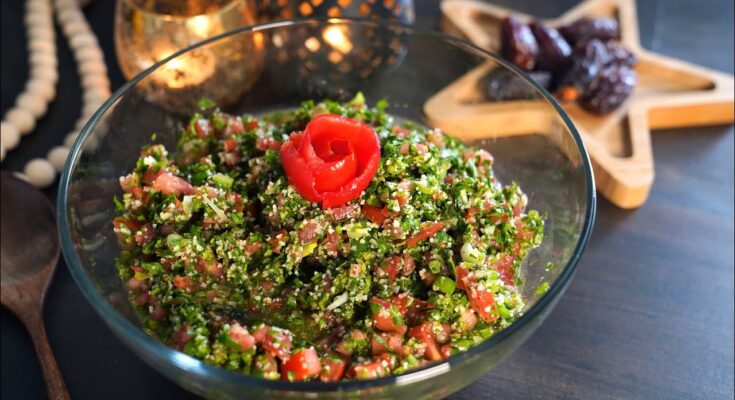Tabbouleh Recipe: Tabbouleh is a refreshing and vibrant Middle Eastern salad that has become a global favorite. Known for its light texture and zesty flavors, it combines finely chopped parsley, mint, tomatoes, and onions with bulgur wheat. The salad is dressed in olive oil and lemon juice, making it both healthy and flavorful. Whether served as a side dish, appetizer, or main salad, Tabbouleh is a versatile recipe that fits any occasion.
The History and Origin of Tabbouleh
Originating from the Levant region, particularly Lebanon and Syria, Tabbouleh has been a staple in Middle Eastern cuisine for centuries. The name comes from the Arabic word “tabboul,” meaning “to season or spice.” Traditionally enjoyed as part of a mezze platter, Tabbouleh highlights the importance of fresh, seasonal ingredients in Middle Eastern cooking.
Why You Should Try This Tabbouleh Recipe
Tabbouleh is more than just a salad; it’s a celebration of flavors and nutrients. Packed with antioxidants, vitamins, and fiber, it’s a healthy addition to any diet. Its preparation is simple, requiring minimal cooking skills, making it perfect for beginners. Plus, its refreshing taste complements a variety of dishes, from grilled meats to wraps and falafels.
Ingredients and Preparation
Fresh Ingredients Needed for Tabbouleh
To make an authentic Tabbouleh, gather the following ingredients:
- Parsley (2-3 bunches): Fresh and finely chopped.
- Bulgur wheat (½ cup): Fine or medium grain.
- Tomatoes (2 large): Ripe and juicy.
- Green onions (4-5): Mild and flavorful.
- Fresh mint (½ cup): Adds freshness.
- Lemon juice (¼ cup): For tangy flavor.
- Olive oil (¼ cup): Use extra virgin for the best taste.
- Salt and pepper (to taste): Seasoning essentials.
Essential Tools for Making Tabbouleh
- Sharp Knife: For finely chopping vegetables.
- Mixing Bowl: Large enough to toss ingredients easily.
- Cutting Board: Provides ample space for preparation.
- Citrus Juicer: To extract fresh lemon juice quickly.
- Sieve or Strainer: For rinsing bulgur wheat and parsley.
Step-by-Step Recipe Instructions
Step 1: Preparing the Parsley – The Heart of Tabbouleh
Start by washing the parsley thoroughly under cold running water to remove dirt or pesticides. Once clean, shake off excess water or pat it dry with paper towels. Use a sharp knife to finely chop the parsley leaves, avoiding stems as much as possible. Proper chopping ensures a fluffy and delicate texture, which is key to authentic Tabbouleh.
Step 2: Soaking and Fluffing the Bulgur Wheat
Place the bulgur wheat in a bowl and rinse it under cold water. Drain and soak it in warm water for about 10-15 minutes, or until it becomes soft and fluffy. Drain any excess water and fluff the grains with a fork to avoid clumping. Some recipes prefer pre-cooked bulgur, but traditional methods rely on soaking.
Step 3: Chopping Fresh Vegetables for Extra Flavor
Dice the tomatoes into small, uniform pieces, ensuring the juices are retained to add flavor. Similarly, finely chop the green onions and fresh mint leaves. Combining these finely chopped vegetables guarantees a balanced and even taste in every bite.
Step 4: Mixing Ingredients to Create Harmony
In a large mixing bowl, combine the soaked bulgur wheat, chopped parsley, tomatoes, mint, and green onions. Toss gently to mix everything evenly. Be careful not to mash the ingredients; instead, aim for a light and fluffy texture.
Step 5: Adding the Perfect Dressing – Olive Oil and Lemon Juice
Whisk together the lemon juice, olive oil, salt, and pepper in a separate bowl. Pour this dressing over the salad and mix gently to coat all the ingredients. Adjust seasoning as needed to balance flavors. The tangy dressing ties the dish together, enhancing its freshness and taste.
Tips for Perfect Tabbouleh
Common Mistakes to Avoid When Making Tabbouleh
Even though Tabbouleh is simple to make, a few mistakes can affect its flavor and texture. Here are some pitfalls to avoid:
- Over-soaking the Bulgur Wheat – If the bulgur wheat is soaked for too long, it may become mushy, ruining the salad’s texture. Always follow the recommended soaking time and fluff it well.
- Not Drying the Parsley Properly – Excess water on parsley can make the salad soggy. Make sure to dry it thoroughly before chopping.
- Chopping Ingredients Too Coarsely – Tabbouleh relies on finely chopped parsley, mint, and vegetables. Large chunks will overpower the salad and affect the presentation.
- Overdressing the Salad – While the dressing is essential, too much olive oil or lemon juice can drown the ingredients. Add the dressing gradually and taste as you go.
- Skipping Fresh Ingredients – Avoid using dried herbs or bottled lemon juice, as they lack the vibrant flavor of fresh ingredients.
Secrets to Achieve Authentic Flavor
- Use Flat-Leaf Parsley: This variety has a stronger flavor and softer texture compared to curly parsley.
- Balance Lemon and Olive Oil: The key to Tabbouleh’s tangy flavor is a perfect balance between acidity and richness.
- Let It Rest Before Serving: Allow the salad to sit for 15-30 minutes before serving. This resting time lets the flavors meld beautifully.
- Add a Hint of Cinnamon or Allspice (Optional): Some traditional recipes include a pinch of cinnamon or allspice to enhance the flavor profile.
Serving and Pairing Suggestions
How to Serve Tabbouleh for Any Occasion
Tabbouleh is incredibly versatile and can be served in multiple ways:
- As a Mezze Appetizer: Serve it alongside hummus, baba ghanoush, and pita bread for a traditional Middle Eastern platter.
- As a Side Salad: Pair it with grilled meats, kebabs, or roasted vegetables for a refreshing contrast.
- In Lettuce Wraps: Scoop the salad into romaine or iceberg lettuce leaves for a fun, low-carb presentation.
- With Stuffed Grape Leaves: Complement the flavors with other Mediterranean dishes like dolmas.
- As a Light Meal: Serve Tabbouleh with feta cheese or chickpeas for added protein.
Best Dishes to Pair with Tabbouleh
- Grilled Chicken or Lamb Skewers – Adds protein while keeping the meal light.
- Falafel or Shawarma Wraps – Perfect for a Mediterranean-themed feast.
- Grilled Fish or Shrimp – Complements the zesty flavors of Tabbouleh.
- Stuffed Peppers or Eggplants – Makes for a wholesome vegetarian meal.
Storing and Making Ahead
How to Store Leftover Tabbouleh
Tabbouleh can be stored in an airtight container in the refrigerator for up to 2-3 days. However, keep in mind that the parsley may wilt slightly as it absorbs the dressing. If you plan to store it longer, you can prepare the vegetables and bulgur separately and mix them with the dressing right before serving.
Can You Make Tabbouleh in Advance?
Yes, Tabbouleh can be made a few hours ahead of time to allow the flavors to develop. For the best results:
- Prepare Ingredients in Advance: Chop the parsley, tomatoes, and mint and store them separately in the fridge.
- Keep Dressing Separate: Add the lemon juice and olive oil just before serving to maintain freshness.
- Fluff the Bulgur Again: If it clumps in storage, give it a quick fluff with a fork before mixing.
FAQs about Tabbouleh Recipe
What is Tabbouleh?
Tabbouleh is a vibrant and refreshing Middle Eastern salad made primarily from finely chopped parsley, tomatoes, mint, onion, bulgur wheat, and seasoned with olive oil, lemon juice, salt, and pepper.
How do you choose the best ingredients for Tabbouleh?
Select fresh, firm tomatoes, a bunch of vibrant green parsley, and high-quality bulgur. For the best flavor, use freshly squeezed lemon juice and a good extra virgin olive oil.
Is Tabbouleh gluten-free?
Traditional tabbouleh is not gluten-free as it contains bulgur wheat, which is a type of whole grain wheat. However, you can make a gluten-free version by substituting bulgur with quinoa or finely chopped cauliflower.
Can Tabbouleh be made ahead of time?
Yes, Tabbouleh can be made a few hours in advance, allowing the flavors to meld. However, it’s best consumed the same day as it’s made to maintain the freshness and texture of the ingredients.
What are some variations of Tabbouleh?
You can experiment with Tabbouleh by adding cucumber, pomegranate seeds, or chickpeas. Some variations replace bulgur with couscous or even rice for a different texture.
How should Tabbouleh be served?
Tabbouleh is typically served cold as a side dish or appetizer. It pairs wonderfully with grilled meats, falafel, or as part of a mezze platter.
Conclusion
Tabbouleh is a timeless dish that brings freshness, flavor, and nutrition to your table. Its simplicity, combined with the richness of Mediterranean ingredients, makes it a must-try recipe for any home cook. Whether you’re hosting a party, preparing a quick lunch, or experimenting with Middle Eastern cuisine, Tabbouleh is always a hit. Try this step-by-step recipe and enjoy a burst of flavors in every bite!



